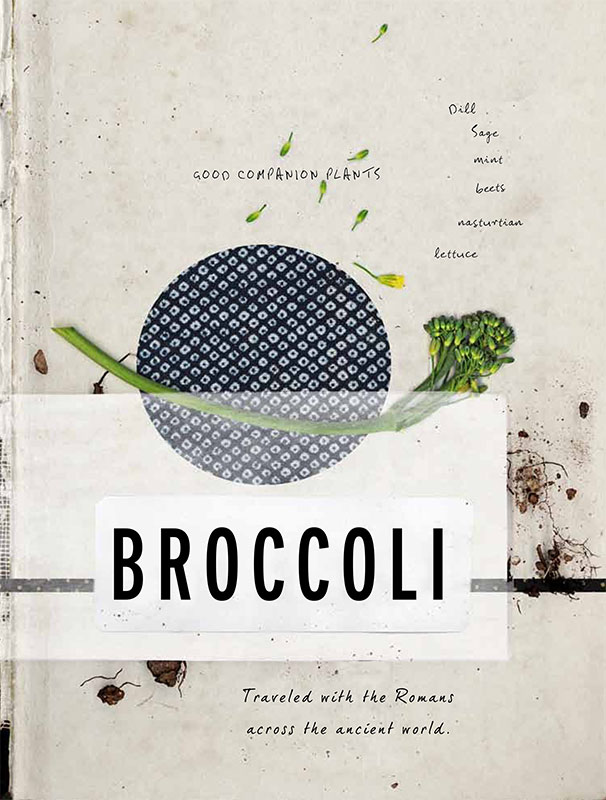
Broccoli is a member of the very large Brassica genus, which includes quite a few of my favorite vegetables such as cabbage, Brussels sprouts and cauliflower. All plants in the Brassica family are at their best through autumn, winter and spring. It also means they are quite slow growing. Broccoli, from planting to harvest, will take 3–4 months for a full head to ripen.
RECIPES
LINGUINI OF BROCCOLI, HERBS & HAZELNUT CRUMB
BROCCOLI, CAPER & RAISIN DRESSING
Broccoli is native to Italy, where it has been cultivated since ancient Roman times. It was even mentioned in Apicius’ book, one of the earliest surviving cookbooks, which gives us great insight into what the Romans ate and grew.
It came to England with the conquering Roman legions, who called it “broccolo,” which translates as cabbage flower. The English at that time tended to call it “Italian asparagus,” a quite misleading and confusing name, to be honest. Cabbage flower is actually much more apt and correct as broccoli and all the members of the Brassica genus originally descended from the cabbage. It was most likely selectively grown by farmers for its flowering head (kind of like an early form of genetic modification, if you will) and gradually became a species in its own right.
As it travelled with the Romans across the ancient world, broccoli became naturalized into many diets and cuisines. Asians love it and use the whole plant—trimming the woody outer layer from the stalk and slicing the sweet inner stem to use in stir-fries. They have also bred their own broccoli, called gai larn (otherwise known as Chinese broccoli).
Broccoli is at home in modern French cookery, and Italians love it, too, using it simply in classic dishes like orecchiette (little ear-shaped pasta) with chili, oil, bread crumbs and Parmesan. The flavor of the broccoli really shines through in this pasta dish. And the leaves themselves are lovely and sweet when sautéed.
There are a few different varieties that are common now, but they are relatively new breeds like the Calabrese Sprouting and classic Albert (the one found in supermarkets). The Romanesco is another variety. It’s very bizarre looking—it’s quite pointy, looks like it’s wearing a crown and is a lighter green color. It has a tighter head, which makes it look more like a cauliflower but it has a broccoli flavor. Then there are the modern hybrids like broccolini, which has been bred for its long, fine stalks, and broccoflower, which as the name suggests is a cross between broccoli and cauliflower.
When you are cooking your broccoli, or anything green for that matter, be aware that when it loses its beautiful vibrant color and begins to turn dark, this means it is starting to lose its nutrients. This is a shame for a plant like broccoli, as it is rich in vitamin A, lots of different vitamin Bs and even contains a good amount of vitamin C. Then there are the good minerals it carries like folic acid, calcium, manganese and zinc. To retain as many of the vitamins in the broccoli as possible (and avoid them leaching out into the cooking water for you only to chuck down the sink), cut your broc into small florets. This will reduce the cooking time also. You could even try it raw—in a similar fashion to the cauliflower salad recipe. Like most vegetables, broccoli should be served al dente, not mushy, and it should have a nice mouthfeel and bite to it.
If you are going to have a go at growing your own lovely broccoli, then just remember, being a Brassica, don’t attempt to grow broccoli through summer: if you do, it will bolt and flower before it has produced a proper head, and you will get spindly florets instead. Stick to autumn, winter and spring crops.
The Brassica genus as a whole is susceptible to various pests. And broccoli will most definitely attract white fly and cabbage moth. A pyrethrum spray will get rid of these pests, but if you want a natural deterrent in the form of a companion plant, then put in some thyme or rosemary. Their strong fragrance will deter the cabbage moth. Dill is also a good companion as it will attract predator wasps that eat the moths. However, if you don’t want to encourage wasps into your garden, stick with the stronger smelling herbs instead.
Broccoli is a frost-hardy plant once established, but not as a young seedling, so if you know there is going to be a frost, it’s wise to make a frost cover to protect your babies. Just take a 8-cup capacity milk bottle and cut it widthways at the top of the label and place the cover over your seedlings. It will not only protect them against frost but it will also stop slugs and snails getting in.
Another way to protect the seedlings is to plant them close together. Once they have established themselves, you need to keep a lookout for any sign of flowering. The minute you see a flower, clip it—this will prevent the plant from going to seed and help produce a tighter head of broccoli.

LINGUINI OF BROCCOLI, HERBS & HAZELNUT CRUMB
SERVES 2 (GREAT WHEN YOU GET HOME AND ARE IN A RUSH)
If you’ve never tried this quick and simple dish at home before, well, this may just become your new best friend.
¼ CUP HAZELNUTS
1¾ OUNCES CIABATTA BREAD (CRUSTS ON), TORN INTO PINKY-FINGERNAIL-SIZED PIECES
2 TEASPOONS THYME LEAVES
6¾ OUNCES DRIED LINGUINI
2 TABLESPOONS BUTTER
1 GENEROUS TABLESPOON OLIVE OIL
¾ CUP PANCETTA, DICED (OPTIONAL)
1 LARGE SHALLOT, SLICED
1 GARLIC CLOVE, THINLY SLICED
½ LONG RED CHILI, THINLY SLICED
6 ANCHOVY FILLETS
1 HEAD OF BROCCOLI FLORETS AND STALK, CHOPPED
3 TABLESPOONS PASTA COOKING WATER
3 TABLESPOONS WHITE WINE
8 LARGE BASIL LEAVES, FINELY CHOPPED
¼ BUNCH ITALIAN PARSLEY, LEAVES PICKED AND CHOPPED
JUICE OF 1 LEMON
10 TURNS OF BLACK PEPPER FROM A MILL
FINELY GRATED PARMESAN, TO SERVE
For the hazelnut crumb, preheat the oven to 350°F. Roast the hazelnuts for 5–10 minutes. Place in a tea towel and rub off the skins while still warm. Roughly chop and place in a large bowl. Set aside.
Turn up the oven to 400°F. Place the bread on a baking sheet and bake for 3–5 minutes or until dried and crispy. Add to the hazelnuts, along with the thyme.
Bring 8 cups of salted water to the boil. Add the linguine and cook for 6–7 minutes or until al dente. Take off the heat and allow the pasta to sit in the water.
Meanwhile, place a large skillet over medium heat, add the butter, olive oil and pancetta and cook until the pancetta softens. Add the shallot, garlic and chili, turn down the heat to low and cook until softened. Turn the heat up to medium, add the anchovies and broccoli and cook, stirring frequently, for 4 minutes. Add the pasta cooking water and wine, turn up the heat to high and reduce the liquid to one-quarter. Drain the pasta and add to the sauce. Stir to incorporate all the ingredients. Take off the heat and add the herbs, lemon juice and pepper. Divide among bowls and scatter over the Parmesan and hazelnut crumb (see Note).
Note Any left-over hazelnut crumb can be kept in an airtight container in the cupboard area for up to 3 months—I’ve always a little up my sleeve just in case I think a dish may need it.
BROCCOLI, CAPER & RAISIN DRESSING
SERVES 4–6
Not only does this dressing go well with broccoli, but it’s also great with a simple piece of broiled steak. Try it out with other vegetables and fish too. You’ll be amazed by how much you will fall in love with this dressing. It’s the new-age pesto. It keeps for days on end in the fridge, just as long as it is submerged under olive oil.
2 SMALL HEADS OF BROCCOLI
SEA SALT
1 TABLESPOON SALTED BABY CAPERS, RINSED
1 TABLESPOON RAISINS, SOAKED FOR 5 MINUTES IN WARM WATER, THEN DRAINED
3 ANCHOVY FILLETS
1 RED BIRD’S EYE CHILI, HALVED, SEEDS REMOVED AND CHOPPED
1 GARLIC CLOVE, CRUSHED
5 BASIL LEAVES
2 TEASPOONS BALSAMIC VINEGAR
JUICE OF ½ LEMON
⅓ CUP EXTRA VIRGIN OLIVE OIL
SEA SALT AND FRESHLY GROUND BLACK PEPPER
For the caper and raisin dressing, add all the solid ingredients to a large mortar and pound to a sticky paste consistency. Add all the liquid ingredients and taste for seasoning. Add salt and pepper if needed but remember the anchovies and capers are naturally salty. Set aside.
To prepare the broccoli, first peel the stern. I love broccoli stem so don’t throw this out. Peel the stem, then cut each floret so that it has some stem attached. (Discard the core of the stem.) By the end you should have what looks like hand-cut broccolini with the exception of a few florets and bits.
Bring 4 cups of water to the boil with some salt. Add the broccoli and cook for 3 minutes, then drain. Place in a bowl and add enough of the dressing to heavily coat the broccoli. Serve straight away.
BROCCOLINI & GRAINS
SERVES 4
This dish is delicious with some steamed chunky white-fleshed fish or a roasted lobster tail (if you’re flush or have just caught your own). You can use any type of whole grains but I recommend the ones below to achieve the correct texture and nuttiness for this dish.
2 POUNDS 4 OUNCES CLAMS, SOAKED IN WATER FOR 20 MINUTES, THEN THOROUGHLY RINSED AND DRAINED
1¼ CUPS WHITE WINE
1 CUP COOKED QUINOA (SEE INSTRUCTIONS)
1 CUP COOKED PEARL BARLEY (SEE INSTRUCTIONS)
½ CUP COOKED SPELT GRAIN (SEE INSTRUCTIONS)
½ CUP COOKED FREGOLA (SEE INSTRUCTIONS)
1 BUNCH BROCCOLINI, CHOPPED
2 TABLESPOONS MASCARPONE
½ CUP FINELY GRATED PARMESAN
2 TABLESPOONS CHOPPED SORREL
2 TABLESPOONS CHOPPED ITALIAN PARSLEY
6 BASIL LEAVES, CHOPPED
FINE SEA SALT AND FRESHLY GROUND BLACK PEPPER
Place a saucepan (measuring about 10½ inches in diameter by 4¼ inches deep) over high heat. Once hot, add the clams, then the wine. Cover with a tight-fitting lid and cook for 5–7 minutes or until the clams have opened. Pass through a fine strainer, reserving both the clams and the juices. Pick the clam meat from the shells.
Wash the pan, then place all the grains in it. Add enough of the reserved clam cooking juices to cover the grains by ⅝ inch. If there isn’t enough liquid, add some water. Bring to a boil, add the broccolini and clam meat, turn down to medium heat and cook. Once the broccolini is tender, fold in the mascarpone, Parmesan and herbs. Season with salt and pepper and serve.